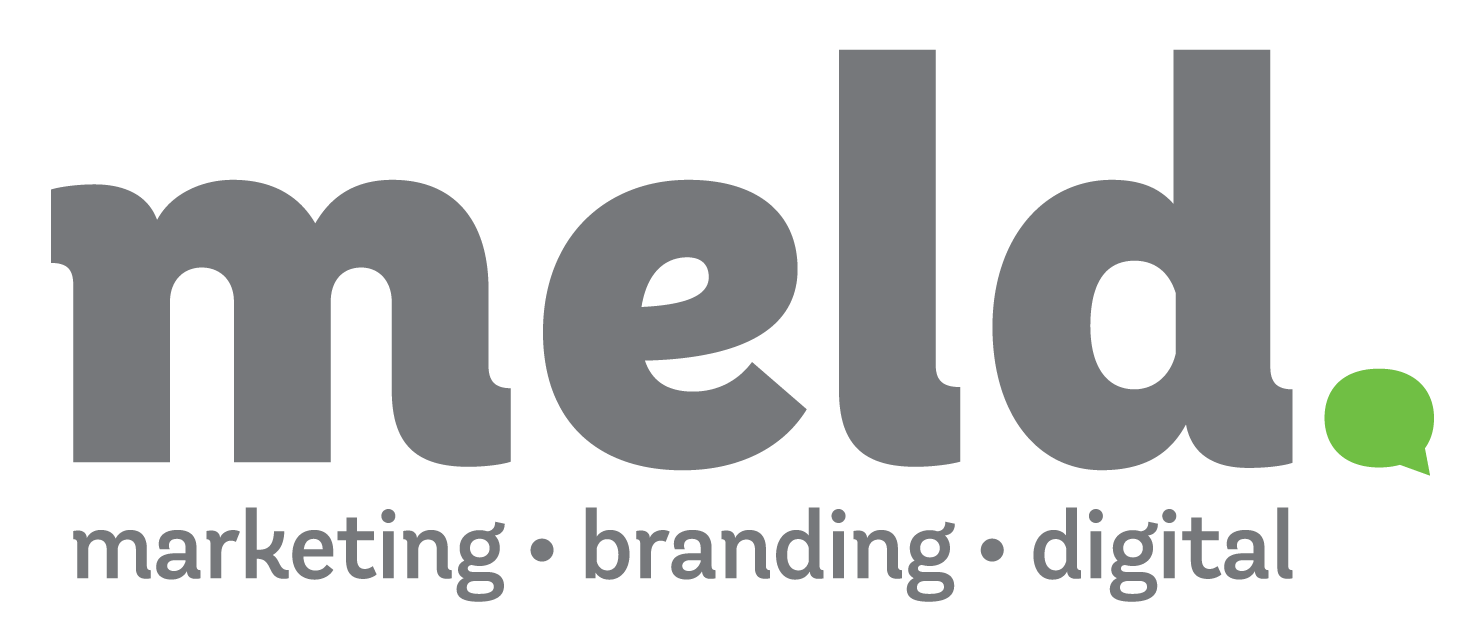There are few projects Meld Senior Graphic Designer Nate Collins doesn’t touch. As our leader for all things visual creative, Nate is essential in helping clients tell their brand stories.
While we’d love to take a look inside his mind, we settled for asking Nate some of our top questions about his design process and about brand identity.
Q: How did you become interested in graphic design?
A: Honestly, it was drawing as a kid. I drew anything from portraits to animals to buildings. I started sketching logos. Sometimes I would do my initials or initials for friends. Then I would draw shoes and find myself designing the logos on shoes, t-shirts, and clothes.
When I started getting closer to college, my mom said, “Hey, you should check out a graphic design program.” And the rest is history.
Q: What tasks make up your day as Meld’s Senior Graphic Designer?
A: Logo design and building brand identities are big tasks for me. It can be anything from full brand identities to logos or color palettes, photography, and more. I also support the social media team by creating graphics for posts or sourcing images.
If there’s a web project, I’m working on pages for the website’s sitemap, working with the content team to infuse that copy into the site, as well as just overall design with all of the images and the text icons. You might also find me at a photoshoot, directing, or helping strategize on-site with clients.
Q: You’ve helped create brands from scratch and refreshed brands. When doing a refresh, what’s the first thing you evaluate about a business’ current brand?
A: One of the first things I look at is the logo because that’s one of the most recognizable things to consumers. Think of a retail space—for example, the logo is on the outside of the building. When you see that logo, you may be interested in finding out more about the business, so you’ll Google the name, you go to the website, and the logo will be there. Usually, that’s one of the first things I look at because that’s a significant piece of branding. It’s not the entire thing, but it’s one of the first things we evaluate about a company: the name and the logo tied to it.
After that, it’s just peeling back the layers—colors, photography style, messaging, tone, and fonts. Because those carry a lot of brand personality as well.
Q: Where do you turn to first when exploring a client’s brand for a refresh?
A: The website. We know it’s the crown of branding. The website says (or should say) a lot about a company because that’s where you can really tell the market who you are.
Next, I ask, “What do they look like on social?”
Q: Can you walk us through the steps of your design process?
A: One thing I like about Meld is that we start interviewing the client and asking good questions; What do they like about their current brand? What would they like to see refreshed? Why are they looking for something different?
The next piece for me is seeing what people are doing in the landscape. I look at the lay of the land because the last thing you want to do is design a logo and then find there’s already one similar. Next, I usually do a quick sketch on paper of what’s in my head and then take that idea to Illustrator. Once I have those core elements of a logo, I start matching a font to the aesthetic of the logo.
Next up is color. The psychology of color plays a huge role in the process. Think about the energy the colors bring—if it’s a restaurant, you might think about vibrant colors or natural colors, and the sense of energy each would invoke in people that walk in.
Then you tie in the photography style, working with photographers to set up a strategy to get the look and feel and the essence of what that brand is in a photo. After that, I think about the other layers like icons and patterns, and establishing those in a way that mirrors the core logo.
Q: Can you explain the difference between brand identity and logo design and why both are crucial?
A: The logo is part of a brand identity. Sometimes people think all they need is a logo. We come in and ask, How does that logo work on social media? How does that logo translate to apparel? How does your logo look in one color? Once that’s established, how does it apply to all the variations, whether that’s a logo with a tagline or just the icon? Then how does that brand expression pair with the logo?
The colors, icons, fonts, brand tone, and messaging all play into a brand identity. Every time someone comes across a client’s brand—whether that’s on the web, on social, in person in a store or at a business—you have a very consistent look and feel throughout the entire experience. A brand identity helps keep that consistent, versus a single logo is just one piece of that. When someone just has a logo and no brand strategy, it goes off the rails really fast.
Q: If you had to list a ‘magic equation’ for branding, what would that include?
A: In today’s world, it needs to be mobile-first, meaning that logo can scale down to fit the mobile world. You need an established color palette. Fonts that feel timeless. I would say you also need strategy and messaging. One of the things I like to tell people is I can design a logo, but if the messaging doesn’t match, it’s not going to work.
Everything also has to be scalable and easy to execute across multiple platforms, including print web, signage, etc. Take the friction out of it. If a brand is hard to execute, it gets really frustrating for people.
Q: Is there anything you see that often gets overlooked in business branding?
A: I think it’s consistency. If you don’t have an established brand guide, it’s really easy for things to go sideways very quickly. That is definitely the most overlooked thing—having consistency backed by a brand guide.
Q: What’s one brand whose identity and/or design you admire?
A: My favorite global rebrand was Formula One’s new logo. I wish I had designed that. It does everything in such a simple mark and it looks like a race track. Every time I look at it, I wish I could have done that.
Another brand I’m extremely compelled by is ASRV. The brand has experienced more of an Instagram-driven growth. They offered tank tops in the beginning and eventually a full suite of premium athletic wear. They nail it with their brand tone and messaging, aesthetic, and video. I absolutely love their concept and how they go about marketing their clothes.
Q: What has been your favorite Meld project to work on and why?
A: I love Ray Orthodontics, just because it was a match made in heaven. That was a full brand build and the client left so happy with the final product.
I would say my next favorite would probably be Advantage. As far as a brand refresh, they really needed something fresh.
When you look at where Advantage came from to where they are now, the fresh standpoint definitely elevated them to where they need to be. They also stand out because the client literally was like, “You had me at ‘hello.’” That was it. He didn’t want or need to see the second concept. He was that excited about concept one.
Q: Where do you find inspiration?
A: Honestly, Pinterest is one of my favorite apps. I find a lot of inspiration from Pinterest. After that, I subscribed to newsletters that curate blogs and news articles about the design world.
And it’s just going out and seeking—the hunt to see what’s out there. I love to see what other industries are doing as a whole. One of my favorite books is The Innovation Secrets of Steve Jobs by Carmine Gallo. Apple is not just the iPhone anymore. It’s the retail experience. It’s actually how you use their products.
I also find inspiration from what other companies are doing. Not just specific to their branding in general. It’s the whole customer experience.
Thinking about your company’s brand and how it could use a refresh? We’d love to chat! Reach out and let us know what you have in mind.



